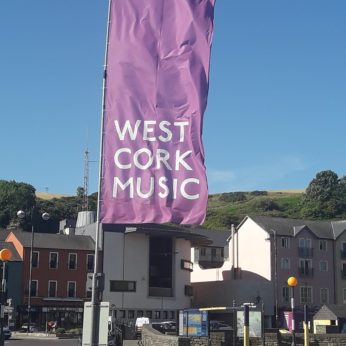Composer: Franz Schubert (b. 1797 - d. 1828)
Performance date: 03/07/2017
Venue: Bantry Library
Composition Year: 1828
Duration: 00:48:41
Recording Engineer: Richard McCullough, RTÉ lyric fm
Instrumentation Category:String Quintet
Artists:
Pacifica Quartet (Simin Ganatra, Sibbi Bernhardsson [violins], Masumi Per Rostad [viola], Brandon Vamos [cello]) -
[quartet]
Johannes Moser -
[cello]

Schubert’s
last years were a race against time. He knew he was fatally ill and
this clearly heightened the emotional perceptions of his inspired
romantic imagination. He died on 19th
November 1828, after a ten-day illness. During the last days he was
often delirious, but when he was lucid he spent his time correcting
proofs of Winterreise.
In
the two previous months he had completed the last three magnificent
piano sonatas in C minor, A major and B flat; the thirteen songs that
make up Schwanengesang;
the
joyous Der
Hirt auf dem Felsen that
brings clarinet and soprano together; and, as if that were not
enough, this overwhelming Quintet. There seems to have been no
commission for these works, just a desperate need to keep writing
while he still could.
Schubert
undoubtedly knew the Mozart string quintets with the two violas, and
that composer’s tactic of dividing his quintet into two trios.
Schubert chose instead the extra cello and divides his ensemble into
two quartets, which gives the single extra instrument a
disproportionately more powerful effect. He was particularly taken by
the luminous quality of the cello’s top string, as is wonderfully
demonstrated by the first movement’s second subject, where the two
cellos duet serenely high above the viola’s bass line. The extra bass
instrument also gives him more freedom to explore the lyrical
potential of the cello, as well as giving rein to the richer tenor
textures, as in the Adagio
where the theme is played by the second violin, viola and first
cello.
The
long-breathed opening is deep with mystery, soon to be dispelled by a
greater sense of urgency. A triplet figure arises as the signature of
this new momentum, and drives the music to the expected cadence,
where a harmonic twist moves to the unexpected key of E flat, an
inspired preparation for the gorgeous melody of the second subject.
This begins in the two cellos, then the violins, and finally the
first violin and the viola. The exposition is rounded off by a new
march-like idea, which dominates the development that follows the
exposition repeat. The extended and emotionally intensified
development culminates in the driving triplets that led to the second
subject, and a seamless return to the opening material and the
recapitulation. The coda manages to encompass both the power and the
mystery of the opening, before this huge twenty-minute movement is
finally closed.
The
timelessness of the work’s opening is echoed and intensified by the
otherworldly Adagio.
The impression of calm is constantly undermined by the first violin’s
decorative comments, but each time reaffirmed by the pulsation of the
plucked cello. This finally erupts in the F minor middle section,
where we experience some of the terror and anguish that Schubert knew
so well. The driving triplet rhythms from the first movement mutate
into dark and bitter foreboding, which the warmth of the main theme
only manages to calm after a long struggle. The return to the Elysian
Fields of the opening is accomplished as the F minor mode collapses
exhausted, and the familiar strains re-emerge with greatly elaborated
decorations. Eventually the cello pizzicatos return, and the utter
peacefulness of the opening is almost recovered in music of unearthly
beauty.
The
primeval physicality of the Scherzo’s peasant dance comes as a
brutal shock after so much introspection. There is an unquenchable
joy in living in this music, an earthy power that generates a
short-lived but all-consuming elation. The Trio is the absolute
opposite, a despairing travail through the valley of the shadow of
death, which reminds us of that other winter’s journey he wrote
about, and looks forward to his own death two weeks later. The return
of the Scherzo has this time an element of frantic desperation.
The
finale is a procession of dances from the wild Hungarian melody at
the beginning to the gorgeous Viennese lilt of the heart-warming
second subject. Schubert wrote literally hundreds of dances for
dance-crazy Vienna, and he exults here in his skill. But even here
the demons lurk in moments of threatening quiet and bursts of
frenetic energy. The final section is Schubert at his most exuberant
driving the music to a dramatic finish.
Francis
Humphrys
Copyright © 2025 West Cork Music. All rights reserved.
Designed and developed by Matrix Internet